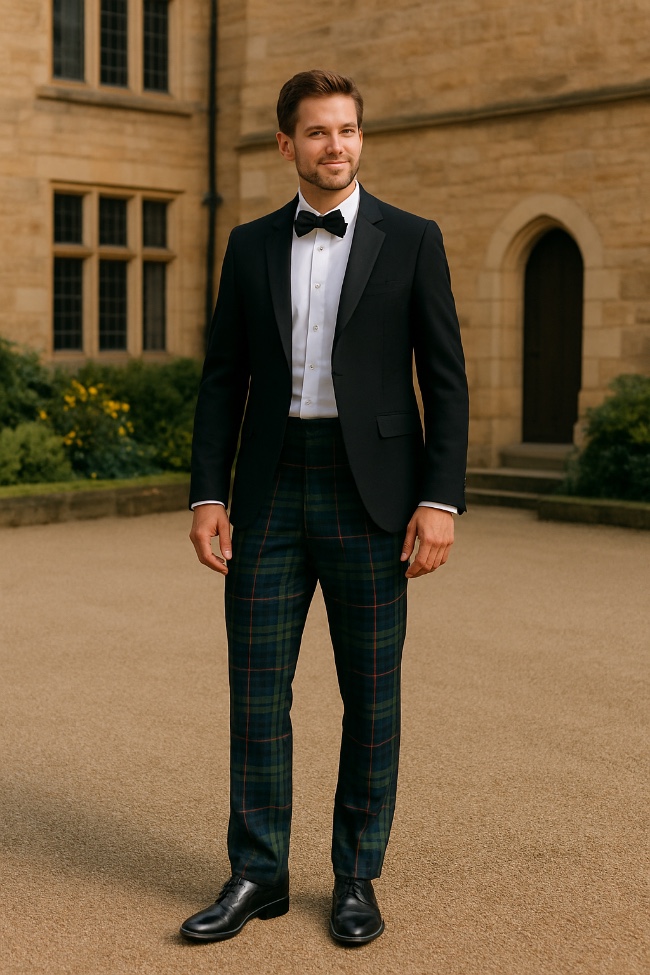If you’ve been invited to a wedding, ceilidh, or another formal event in Scotland, you might find yourself wondering: What exactly should I wear? For many, especially those with Scottish roots living abroad or attending a Scottish event for the first time, the idea of wearing traditional formal attire—especially a kilt—can be exciting but also a little daunting.
This guide is here to help.
Whether you're a novice Scot, someone exploring their Scottish heritage, or simply a guest wanting to honour local traditions, this guide will walk you through everything you need to know. From understanding the significance of the Highland dress to knowing how to match your tartan tie with a sporran, we’ll cover all the essentials of looking the part and feeling confident.
We’ll explore the different types of Scottish formal events—weddings, Burns Night suppers, formal dinners, white tie events and more—and what level of dress each one calls for. Then we’ll break down each part of the traditional outfit, including jackets, kilts, accessories, and tips on how to wear them with pride and timeless elegance.
Wearing Scottish formal attire isn’t just about looking good—it’s about participating in a rich cultural tradition that spans centuries. By the end of this guide, you’ll not only know what to wear, but you’ll understand why you’re wearing it.
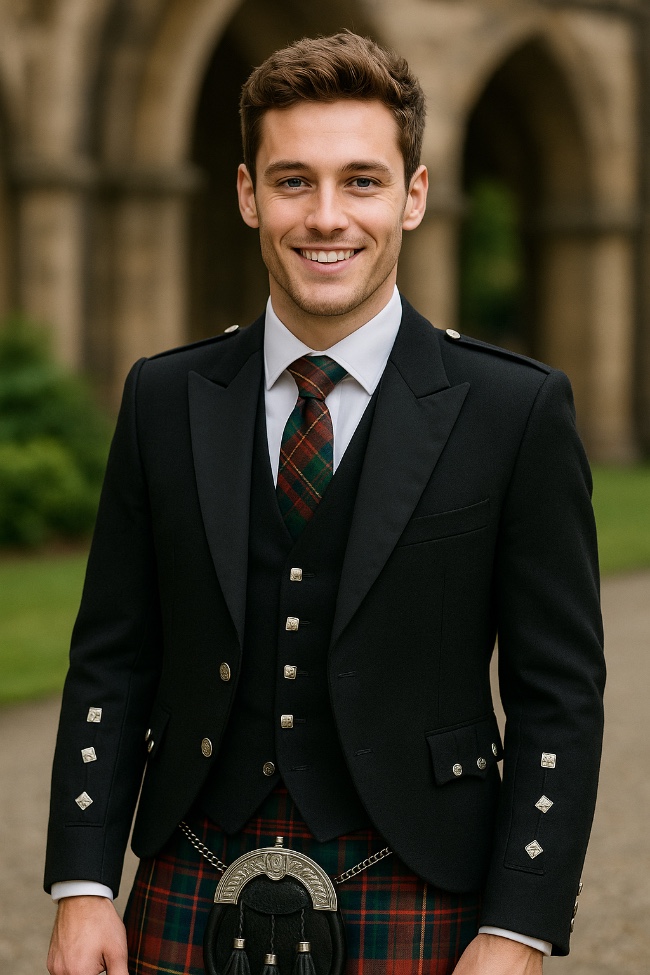
Highland Wear for Different Formal Occasions
Scotland has a proud tradition of dressing well for significant events, and formal occasions here can range from jubilant celebrations to solemn gatherings. Knowing what to wear—and when—is key to respecting the occasion, feeling confident, and honouring Scottish custom.
From the sweeping elegance of a white-tie gala to the time-honoured traditions of a military ceremony, each type of event has its own expected level of formality. Some occasions call for the full Highland dress with all the trimmings, while others may be more flexible, allowing for personal touches or slightly less formal variants. You might be dressing for a wedding, a Burns Supper, a black-tie dinner, a funeral, a graduation, a St. Andrew’s Day ball, or even a royal garden party—each with its own set of cues.
This section will guide you through the most common types of formal events in Scotland and what’s considered appropriate for each, whether you're wearing a kilt, a tartan tie, or a full Prince Charlie ensemble. We’ll also help you understand the difference between white tie, black tie, Highland formal, and semi-formal dress, so you can make the right impression.
Weddings in Scottish highland dress
A Scottish wedding is the perfect occasion to embrace the full kilt outfit, combining elegance, tradition, and national pride. Whether you're the groom, part of the wedding party, or a guest, Highland dress adds a sense of ceremony that’s hard to match—and it photographs beautifully too.
The Essentials of a Formal Kilt Outfit for a Wedding
For a wedding, the most common choice is to wear a formal kilt in your chosen tartan pattern. This could be your clan tartan, a district design, or simply a colourway that suits the event’s theme. The kilt should be worn high on the waist and fall to just above the knee.
Your outfit will typically include:
-
A Prince Charlie jacket – a short, tailored black jacket with silver buttons, designed specifically for formal evening wear.
-
A six-button waistcoat – traditionally black, matching the jacket and offering a structured, elegant silhouette.
-
A white formal shirt – plain-fronted or pleated, with stiff cuffs. Some opt for a wing collar to accommodate a bow tie.
-
A white Marcella bow tie – a classic choice for a wedding, adding timeless elegance to the outfit.
-
Optional lace cuffs – for added flair, particularly if you're part of the bridal party or want a more regal touch.
From the Kilt Down
The formal kilt is the centrepiece, but your accessories matter too:
-
A kilt pin – placed on the lower corner of the front apron to weigh it down and add decoration (not to pin both layers).
-
A dress sporran – the most ornate type of sporran, usually made from fur and silver, worn at the front with a chain belt.
-
Knee-length wool socks – traditionally cream or off-white, rolled to just below the knee.
-
Traditional sock garters (also called flashes) – worn under the fold of the socks, with ribbons that match the kilt’s colours.
-
A sign dubh – a small ornamental knife tucked into the right sock, traditionally worn with Highland dress.
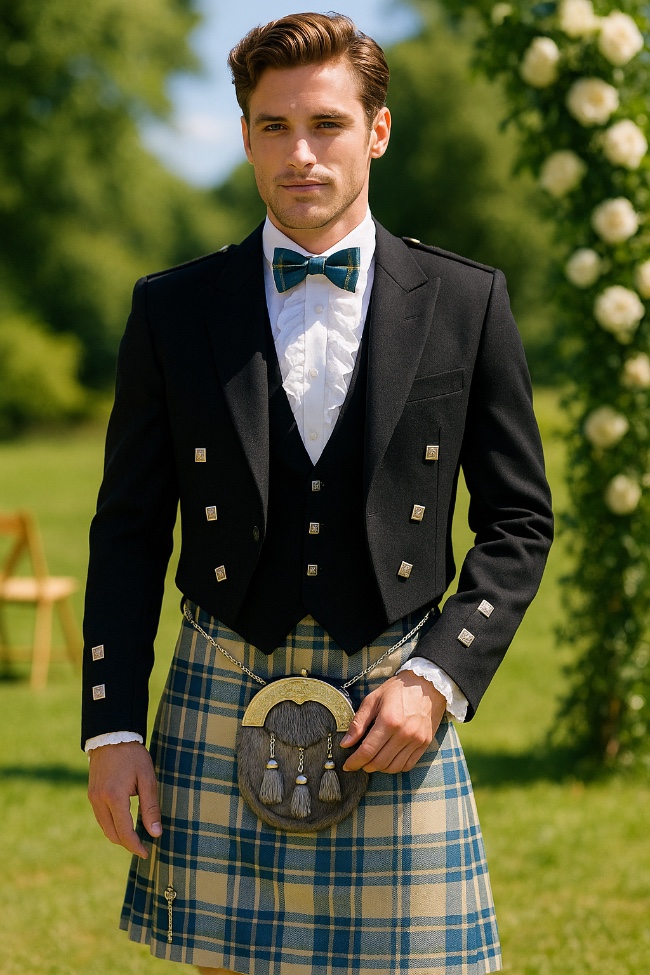
Footwear
Pair everything with black ghillie brogues—lace-up shoes with long laces that wrap around the ankle and tie below the calf. These are the traditional shoes for Highland wear and work well with formal settings.
Black formal shoes are also a great option if you're not ready to go full ghillie.
Traditional Burns Supper
A Burns Supper is a heartfelt celebration of Scotland’s national poet, Robert Burns, and it's an occasion steeped in tradition, poetry, humour, and whisky. Held annually around 25th January, these gatherings can range from informal pub dinners to grand formal affairs in castles or banqueting halls.
If you’re attending a formal Burns Supper, you’ll want to embrace the Scottish heritage of the evening by wearing a full kilt outfit—but this event allows for a little more personal taste and creativity than a strict wedding dress code might.
Dress Code: Traditional with a Literary Twist
At a Burns Supper, tradition is key—but so is personality. Many guests wear formal kilt attire, but with softer edges and period flair. There’s room to nod to the romantic 18th-century style Burns himself might have worn, especially if you're involved in reciting poetry or addressing the haggis.
Building Your Burns Supper Look
-
Swap the Prince Charlie jacket for a dark Argyll jacket if the evening leans less formal, or choose a richly textured tweed jacket in earthy tones to reflect the rustic charm of Burns’ own time.
-
Consider a waistcoat in a contrasting or complementary tartan—not just a standard six-button waistcoat, but perhaps a four- or five-button style with a curved hem for a more vintage look.
-
A white formal shirt is still the go-to base, but feel free to replace the usual white Marcella bow tie a black bow tie, with a tartan necktie or even a soft wool cravat, especially if you're giving a toast or reciting poetry.
The Kilt and Traditional Details
-
Your formal kilt should still be the centrepiece—choose a tartan pattern that has personal significance or ties to the region where the supper is held.
-
A dress sporran is appropriate, but for a Burns Supper, a leather sporran with Celtic knotwork or thistle detailing is often preferred.
-
Instead of the typical polished kilt pin, consider one with a poetic motif—like a quill, a rose, or a Robert Burns profile.
-
Knee-length wool socks are still worn, but many attendees opt for darker tones—charcoal or forest green—paired with bold traditional sock garters in contrasting colours.
-
Don’t forget the sign dubh, that small ornamental knife tucked into the top of your right sock—it’s both traditional and practical, and many feature intricate designs especially for Burns Night.
Finishing Touches with Personality
-
Footwear can be more varied than at a wedding: while ghillie brogues remain a staple, brogue boots or even vintage leather shoes are seen at more relaxed suppers.
-
Accessories matter: atartan tie made from a family kilt, a lapel pin with a Scottish rose, or a watch chain can all add to the character of your outfit.
-
If you're giving a speech or performing, a draped tartan plaid over the shoulder secured with a brooch can create a striking silhouette.
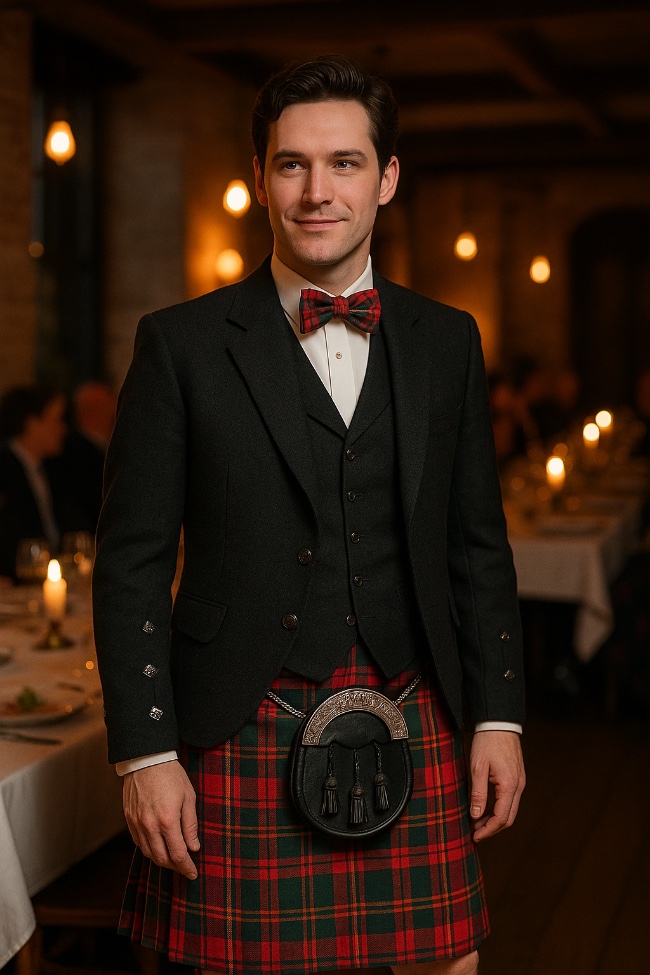
What to Wear to Military Ceremonies and Occasions
Military events in Scotland—and among Scottish regiments worldwide—are steeped in tradition, symbolism, and discipline. From Remembrance services to regimental dinners, parades, commissioning ceremonies, and memorial unveilings, these occasions call for respectful and properly assembled attire, often based on formal Highland dress.
Whether you're a serving member, a veteran, or a civilian guest with a connection to the military, knowing how to dress appropriately is a mark of both pride and respect.
Highland Dress for Military Ceremonies
Formal military-style Highland dress tends to be more uniform and ceremonial than what one might wear to a wedding or Burns Supper. It is often modelled on regimental standards, particularly those of Highland units such as the Royal Regiment of Scotland or various historical battalions.
Highland dress consists of the following core elements, often in more formal materials than civilian outfits:
-
A white shirt with stiff collar—usually worn with a black tie or bow tie, depending on the formality.
-
A traditional Prince Charlie or doublet-style military jacket, often adorned with regimental insignia or buttons.
-
A kilt in a regimental or family tartan pattern, worn high and neat with properly aligned pleats.
-
A short belted plaid, draped over the shoulder and secured with a crest badge, is often worn during especially formal events or if you're in the colour party.
-
A dress sporran, usually with a cantle featuring regimental engraving or silver detailing.
Socks, Garters, and Footwear
Attention to detail is key, especially below the knee:
-
Kilt hose should be worn in cream, grey, or regimentally appropriate colours, pulled up just below the knee.
-
Over these, elastic sock garters or garter ties are worn, often featuring decorative pointed vertical strips of ribbon visible on the outer leg. Some ceremonial kits use silk garter ties in regimental colours or adorned with small flashes.
-
Black ghillie brogues or military parade shoes are typical footwear. In some ceremonial cases, spats may be worn.
Weaponry and Accents
For certain high-ranking officers or ceremonial roles:
-
An ornamental cut down sword may be worn in a frog (a belt-mounted holder), especially at parades or regimental dinners.
-
A crest badge—symbolising your clan or regiment—is often worn on the jacket lapel, bonnet, or pinned to the plaid.
When Not to Go Full Regalia
If you're attending as a guest rather than a participant, there's no requirement to wear full ceremonial Highland dress. A more formal material kilt outfit with kilt hose, smart garter ties, and a restrained sporran is more than appropriate. Avoid excessive ornamentation unless it's part of your unit or family tradition.
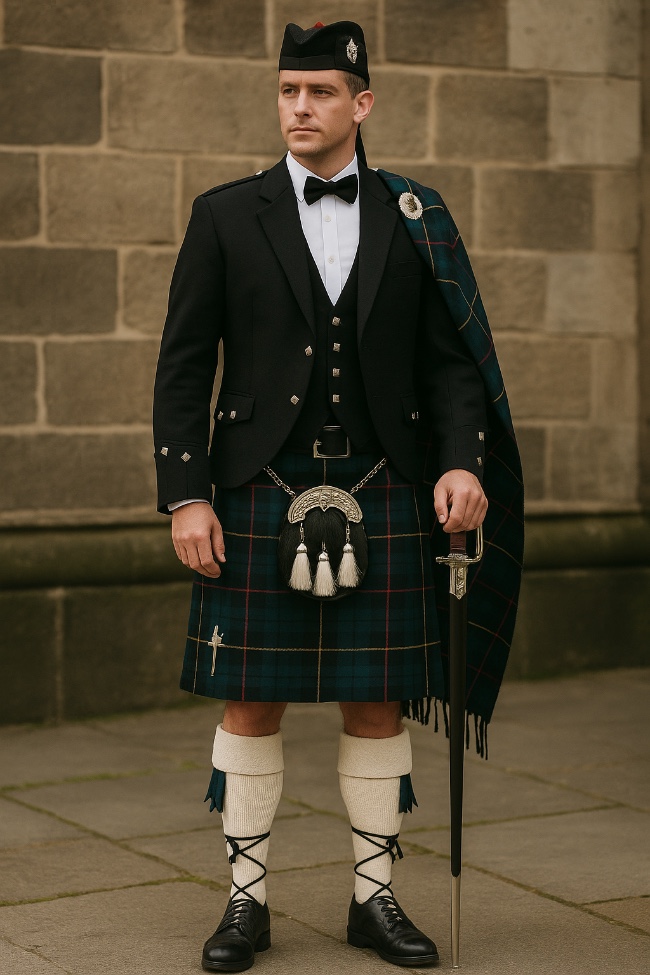
Why am I Wearing This?
It’s a question many first-time kilt-wearers quietly ask themselves as they fasten their sporran or adjust their kilt hose: Why am I wearing this? And the answer is far richer than simply “because I was told to.”
Scottish formal wear—especially Highland dress—is not just about fashion. It is a living tradition, woven through centuries of history, rebellion, pride, identity, and artistry. Wearing it connects you to something larger: your Scottish heritage, your family, and a culture that has survived, adapted, and thrived.
From Function to Formality
Originally, Highland dress was purely practical. The early féileadh mòr (great kilt) was a large swath of tartan fabric, used for warmth, worn belted at the waist, and thrown over the shoulder. In time, it was tailored into the more recognisable modern kilt. Each clan developed its own tartan pattern, not as a strict rule, but as a symbol of kinship and loyalty. Wearing that tartan today still carries that spirit.
Over the years, what was once everyday wear became ceremonial, especially after the kilt was banned following the Jacobite uprisings of the 18th century. When it returned, it did so as a statement of identity—proudly worn at military events, royal courts, and eventually, weddings and formal occasions.
A Visual Language of Respect
The structure of the full kilt outfit speaks volumes: a Prince Charlie jacket signals evening formality; a short belted plaid evokes military tradition; garter ties, sporrans, and the sign dubh all have both symbolic and practical roots. Each element reflects an evolution from function to timeless elegance.
In today’s world, dressing formally in Highland wear is a sign of respect—for the occasion, for your family, and for the generations who wore it before you. It’s a way to participate in something proudly unique and globally recognisable.
More Than Just a Costume
This isn’t fancy dress. It’s not cosplay. It’s not outdated. It’s a tradition that adapts with time while honouring its roots. When you wear Highland dress, you're not just following a code—you’re telling a story. One of history, resilience, and belonging.
So when you pull on those knee-length wool socks or carefully pin your crest badge, remember: you’re not just putting on clothes. You’re stepping into a legacy.
What is a Sporran?
The sporran (pronounced sporr-an, from the Gaelic word for "purse") is one of the most distinctive and essential components of Highland dress. More than just decoration, it plays a vital role—both historically and practically—in the traditional Scottish outfit. However, today, the Sporran is generally seen as a decorative pouch worn with the kilt.
A Practical Beginning
Kilts, as you’ve probably noticed, don’t have pockets. That’s where the sporran comes in. Traditionally made from leather or fur, it acts as a pouch worn at the front of the kilt, hanging from a chain or strap around the waist. It’s used to carry small essentials—historically coins, a flask, or food for the road. Today, it might hold a mobile phone, a cardholder, or a wedding ring.
Styles of Sporrans
There are several types of sporrans, and the one you choose depends on the occasion:
-
Day Sporran – usually simple leather with minimal decoration, suitable for casual or semi-formal settings.
-
Dress Sporran – more ornate, often made from fur with a silver or pewter cantle (the top plate). This is the standard choice for weddings, black-tie events, and formal occasions.
-
Semi-Dress Sporran – a hybrid of the two, with a touch of fur and some decorative elements, making it versatile for a range of events.
How to Wear It
The sporran should hang centrally over the front of the kilt, roughly 3 finger-widths below the belt buckle. It should swing freely when you walk but not bounce too much. It's usually secured with a chain strap around the waist, which sits just below the top of the kilt.
A Symbol of Style and Heritage
While it began as a purely functional item, the sporran has evolved into a fashion statement and a symbol of Scottish heritage. Many feature clan crests or Celtic designs, and for many wearers, the choice of sporran is as important as the tartan of the kilt itself.
So next time you reach for your sporran, remember—it's not just your pocket. It's a piece of living history worn with pride.
What are Ghillie brogues?
Ghillie brogues are the traditional shoes worn with Highland dress, and they’re instantly recognisable by their long laces and distinctive style. More than just formal footwear, they complete the look of the full kilt outfit, adding both practicality and tradition under the pleats.
The Origins of the Ghillie Brogue
The word ghillie comes from Scottish Gaelic and refers to a gamekeeper or outdoor servant—someone who would accompany Highland nobility on hunts. The shoes were originally designed for outdoor wear in wet, boggy conditions.
The brogue’s perforated design helped water drain out, and the absence of a tongue allowed the shoe to dry more quickly. The long laces were wrapped around the ankles and tied above the calf to prevent them from getting stuck in the mud.
Today’s ghillie brogues retain the same lacing style but are made from polished leather with a solid, dressy structure—perfect for formal attire.
How to Wear Ghillie Brogues
-
The shoes are worn without a tongue.
-
The long laces are crossed over the instep, wrapped around the ankle or calf two or three times, and then tied in a bow at the front or side, just below the knee-length wool socks.
-
They’re usually worn with kilt hose and garter ties, and they help anchor the bottom of the outfit with a clean, symmetrical finish.
When to Wear Them
Ghillie brogues are standard at weddings, Burns Suppers, military ceremonies, black-tie events, and ceilidhs. They are particularly well-suited to Prince Charlie jacket ensembles or other formal variations of Highland dress.
While modern alternatives like brogue boots or standard lace-up dress shoes may appear at more relaxed events, ghillie brogues remain the go-to for events where timeless elegance and tradition are paramount.
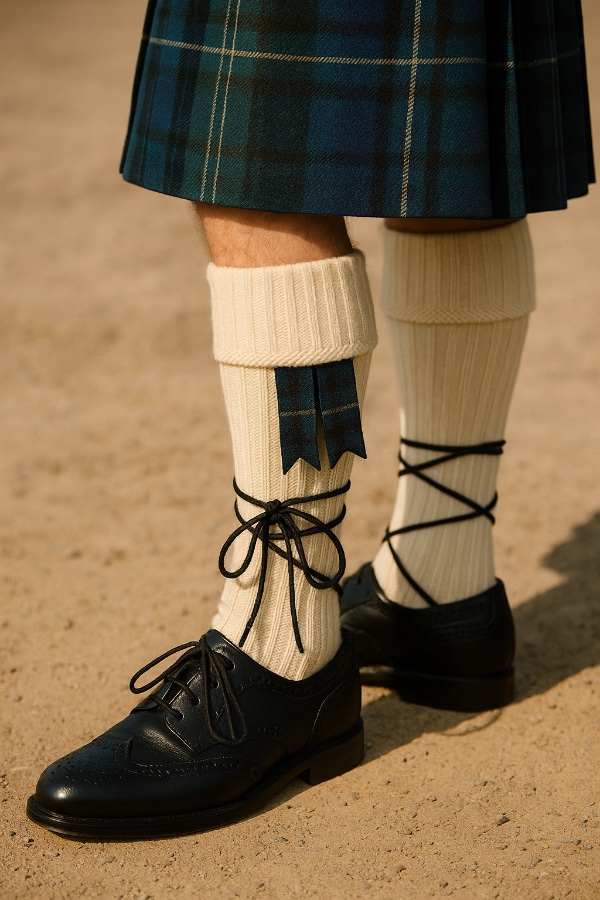
What is a Sgian Dubh?
The sgian dubh (pronounced skee-an doo, Gaelic for "black knife") is a small, single-edged ceremonial knife traditionally worn as part of Highland dress. You’ll often see it tucked into the top of the right kilt hose, with just the handle showing—a subtle but powerful nod to Scottish heritage.
Origins and Symbolism
Historically, the sgian dubh evolved from the sgian achlais—a small blade concealed under the armpit, carried for self-defence or utility. Over time, this practical tool became a standard part of Highland attire. "Dubh" likely refers to its concealed nature, not the colour.
Though no longer carried for practical reasons, it remains a ceremonial symbol of honour and readiness, particularly at formal occasions like weddings, Burns Suppers, and military events.
Styles and Materials
Modern sgian dubhs vary in design, but formal versions are often silver mounted, with ornate hilts, Celtic knotwork, clan crests, or set stones. Handles may be made from ebony, horn, resin, or wood, and the blade—while traditionally sharp—is often now blunt or decorative for safety at public events.
Some popular embellishments include:
-
Silver or pewter pommels
-
Coloured stone tops to match tartans or flashes
-
Clan crest badges inset into the hilt
How to Wear It
The sgian dubh is worn on the right leg, slipped into the kilt hose so that about an inch of the handle is visible above the sock. Left-handed wearers may choose the left side for practicality, though traditionally it’s placed on the right to signal transparency (you’re not concealing a weapon).
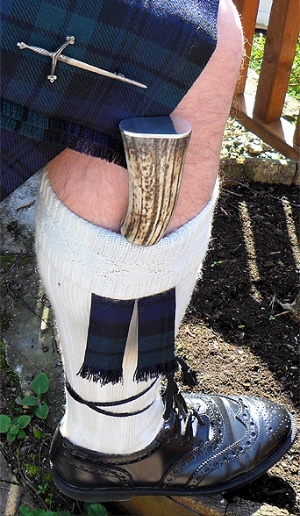
When Is It Appropriate to Wear Tartan Trousers?
While kilts steal the spotlight in Scottish formal wear, tartan trousers (also known as trews) offer a stylish, traditional, and sometimes more practical alternative. But they’re more than just a substitute—they have a long history and a place of their own in Scottish fashion.
A Brief History of Tartan Trousers
Tartan trousers—especially Highland trews—date back centuries. In fact, they pre-date the tailored kilt as we know it today. Originally worn by Highlanders for horseback riding and winter weather, they were made from thick wool tartan and cut snug to the leg. The military popularised them further in the 18th and 19th centuries, especially in Scottish regiments where tartan trews became part of the full-dress uniform.
In modern times, they’re often seen as a more discreet or versatile alternative to the kilt, retaining a strong sense of Scottish heritage without being as ceremonial.
When to Wear Them
You can wear tartan trousers at many of the same events you’d wear a kilt—but they're particularly suitable for:
-
Black tie events where you want a Scottish touch but prefer not to wear a kilt.
-
Winter weddings or formal dinners, especially when kilts might be too cold or impractical.
-
Burns Suppers, where they’re a popular alternative for those who feel less comfortable in Highland dress.
-
Graduations, lectures, or speaking events, where they strike a refined balance between heritage and formality.
-
Golf, of course—this is where tartan trousers became a bold, playful fashion statement. While the golfing versions tend to feature brighter, louder patterns, they’re rooted in the same traditions.
How to Wear Them Well
-
Pair them with a black dinner jacket or Prince Charlie jacket, white shirt, and bow tie for formal events.
-
For less formal occasions, a tweed jacket and open-neck shirt works beautifully.
-
Choose a tartan that means something to you—clan, district, or even personal design.
-
Ensure they’re well-tailored; baggy tartan trousers rarely look intentional.
